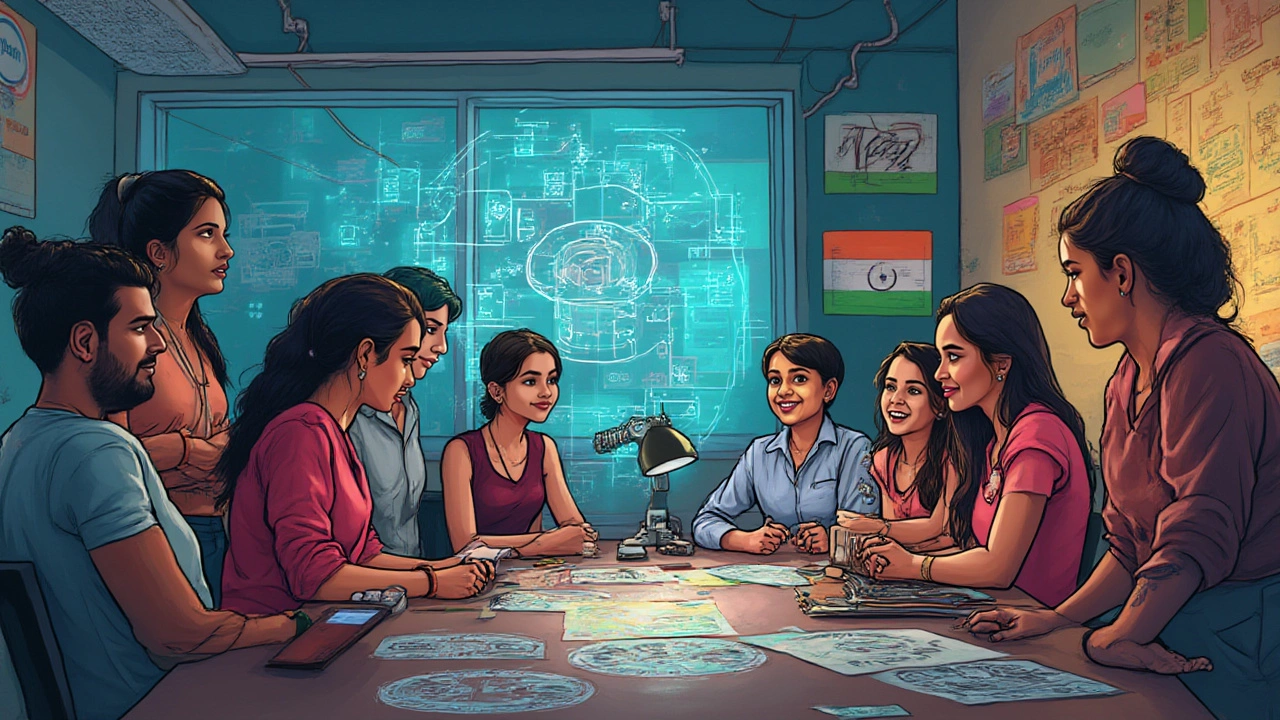Picture this: You’re using a voice assistant that understands your accent, makes sense of your local slang, and runs lightning fast—all thanks to new-age AI chips made not in Silicon Valley or Taiwan, but right in India. Until a few years ago, India was known mostly for IT services and software. If you wanted anything to do with AI hardware—especially the chips powering machine learning, deep learning, or neural networks—you had to look outside the country. That narrative is starting to crack. Now, India’s homegrown brains and businesses are giving the world’s AI chip giants some competition, even if the gap is still obvious.
The Big Names: Who’s Actually Making AI Chips in India?
Let’s clear something up right away: India is not (yet) mass-producing the world’s most advanced AI chips at scale like TSMC in Taiwan or Samsung in South Korea. But things are moving fast, and the last five years have seen some serious players getting into the AI chip arena. This isn’t just about assembling chips or importing and branding—Indian engineers and startups are building custom hardware with Indian R&D, aimed specifically at making AI work for Indian needs.
First up, there’s C-DAC (Centre for Development of Advanced Computing), a government-backed pioneer. C-DAC’s “PARAS” family of chips made headlines in 2023 when they announced a series of AI accelerator chips for edge devices and high-performance applications. These aren’t just prototypes—they’re running in some Indian data centres and edge sensors today. The team is betting big on making chips that run AI faster and use less power, exactly what you need for affordable ‘smart’ infrastructure in Indian cities and villages.
Next, meet the homegrown unicorns. Mindgrove Technologies, born out of IIT Madras, caused a stir with the “Secure IoT Microprocessor Program” and their Shakti processors. In 2024, they unveiled “SRAMAN,” a made-in-India inference accelerator chip designed for small AI models that power consumer gadgets and industrial sensors. Shakti chips already run in various IoT boards and automation products across government projects, and Mindgrove claims their AI hardware can outrun imported chips costing twice as much.
But the real wave of innovation? Startups. Companies like Morphing Machines and InCore Semiconductors (another IIT Madras spin-off) have built AI accelerator chips with open-source RISC-V architecture, which means local companies can actually look at the chip designs, customize them, and even add tweaks for Indian languages or energy use. InCore’s “Vrinda AI” chip, pitched in 2024, grabbed attention because it focused on on-device learning for smartphones, hearing aids, and everything in between. Morphing Machines, meanwhile, is exploring neuromorphic chips—a fancy way of saying the chips mimic the human brain, so AI can get smarter with less power.
Of course, don’t forget Tata Elxsi and Saankhya Labs, who tie up with national space and defence agencies. These firms aren’t just designing chips—they’re making systems for surveillance, satellite imaging, and emergency response that run AI on their custom processors. For anyone following the chip wars, here’s a fun fact: In April 2025, Tata Group signed a publicized deal with a leading US foundry for co-developing an AI-specific SoC (system-on-chip) aimed at self-driving vehicles in India. The hardware will be designed in Bengaluru, manufactured overseas, but tested on Indian roads—next-gen mobility in Indian style.

Government Initiatives and The ‘Make in India’ Push
No company operates in a vacuum—especially in something as expensive as semiconductors. The Indian government got serious about the chip sector in 2022 when it set aside close to $10 billion through its “Semiconductor Mission.” Part of this cash is subsidies, part is grants to R&D labs, and a chunk goes to actual chip-making factories (called fabs). By early 2025, at least six mega projects have kicked off, ranging from foundries set up by India’s own Vedanta-Foxconn JV to design labs funded through the Digital India RISC-V program. The explicit goal: not just to assemble foreign-designed chips in India but to build, design, and test homegrown processors—including those for AI, in every layer from research to production.
Here’s a tip for anyone in tech or manufacturing: Watch for the government’s “Design Linked Incentive” (DLI) scheme. Startups who design AI-optimised silicon get a big chunk of their costs covered. In 2024, 30+ startups—many with AI chip ambitions—bagged these awards. It’s not just lip service: Chennai-based Axiomise and Mumbai’s Vasaka Semiconductors used DLI support to roll out AI inference coprocessors and edge vision chips by mid-2025.
Another major play involves global partnerships. The government has courted TSMC, Intel, and AMD to set up R&D and, potentially, fabrication units. While actual fabrication (especially for bleeding-edge chips) is still limited, collaborations help transfer know-how and high-end design tools to local engineers. For example, Wipro collaborated with AMD in 2024 to develop AI acceleration modules tailored to Indian telecom networks—think rural 5G towers interpreting huge data in real time no matter how patchy the bandwidth.
Then there’s the strategic stuff—defence and space. The ISRO (Indian Space Research Organisation) and DRDO (Defence Research and Development Organisation) are putting a big focus on indigenous AI processors, mainly to avoid import restrictions and for data security. In 2025, DRDO announced test production of “BrahmaNet,” an AI-focused chip designed to process satellite images on the fly, right from Indian satellites over the Indian Ocean. These projects rarely make splashy headlines, but they’re a sign India wants independence across all critical tech, including AI hardware.
The ‘Indianisation’ of AI chips is also about support services. Just writing algorithms isn’t enough—you need the circuit design software, advanced testing kits, and packaging infrastructure to turn an idea into a working chip. Several local EDA (electronic design automation) tool companies—like Tessolve and Sankalp Semiconductor—have expanded to offer chip tape-out and prototyping services specific to AI, meaning a Bengaluru startup can design, simulate, and test a new AI accelerator without needing to fly to California.

What Sets India’s AI Chips Apart – and Where’s the Catch?
No rose without thorns—India’s AI chips have their own flavor of strengths and growing pains. On the plus side, they’re being built for India’s own market realities. That means super-robust chips that keep running even during 45°C summers in dusty towns, support local languages, and crank out good enough AI performance without a power-hungry GPU farm. Many of these chips are focused on “edge AI”—running neural networks locally on cameras, phones, meter readers, or even inside tractors—so that you can get smart features where there’s poor or no internet. EdgeQ, a global player with a huge Indian R&D team, profiled this gap and designed cellular and IoT chips loved by India’s telecom and logistics giants in 2024-2025.
The price? Indian chips are, on average, at least 25% cheaper than imported silicon for edge applications. Take Agatsya, a startup from Pune. Their AI inference modules are running in new-age digital health kiosks in Kerala and Rajasthan, slashing computing costs for local clinics by almost half. Add in government procurement support and you get a recipe for a booming local market.
But here’s where things get tricky. The state-of-the-art AI chips—the stuff NVIDIA and AMD make for training giant language models like ChatGPT—aren’t yet rolling off Indian lines. Fabrication tech in India is still catching up. Most AI silicon designed in India, especially those under 10nm, end up fabbed in Taiwan or China and only packaged and tested in India. This means the country can control design and final integration, but the actual production (the clean-room, white-suits-and-lasers part) often happens abroad for now.
Supply chains also bite. AI chips use advanced materials, from rare earth metals to high-purity silicon wafers. While India has some reserves, it’s nowhere near self-sufficient, so local chipmakers must navigate global supply hiccups. There’s also a massive talent crunch. According to the Ministry of Electronics and IT, India needs at least 50,000 more skilled VLSI (chip design) engineers by 2027 to feed all its expansion dreams. The good news? Universities are adding new semiconductor courses, and companies like Synopsys, Intel, and Google are running “chip design bootcamps” for students and working engineers in top Indian cities.
If you’re in manufacturing, keep an eye out for the next two years. “Make in India” is about to get much more real in chips—especially if Vedanta-Foxconn and ISMC’s fab projects get over bureaucracy hurdles. Local foundries mean actual Indian silicon, not just design and packaging. It also means startups will have cheaper, faster access to industrial-scale prototyping. Some experts expect at least two commercial-scale fabrication plants by 2027 if current trends continue, which could be a game changer for AI and electronics companies across the country.
For most of us, the biggest impact might come quietly: smarter wearables, health devices, agricultural sensors, and transport cards that ‘think’ on their own—never needing cloud connectivity or heavy internet access. Indian-made AI chips won’t just save money; they’ll let millions benefit from AI in places where global tech giants rarely go. For the first time, the next big leap in “Digital India” might just be stamped, literally, on silicon from cities like Bengaluru, Hyderabad, Pune, and Chennai.
